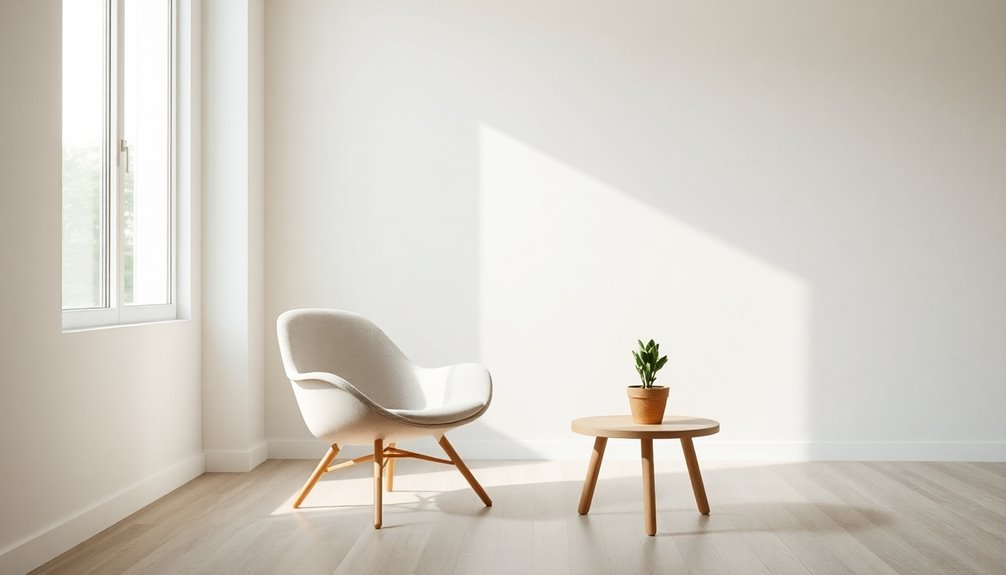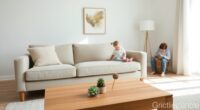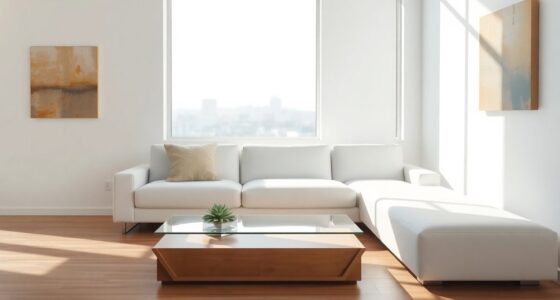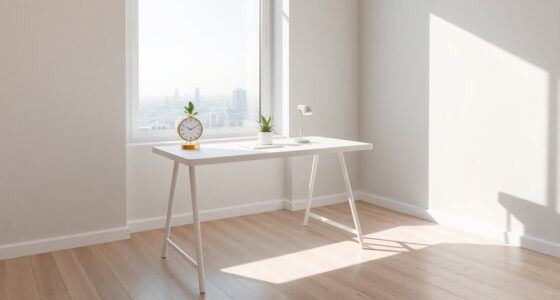Minimalist design in the post-pandemic world is all about creating tranquility and warmth in your home. You'll notice a shift towards ethically sourced materials and a deeper connection to nature. Multi-functional spaces are gaining popularity as they adapt to your lifestyle. Soft shapes and earthy tones enhance comfort, while natural light fosters a calming atmosphere. Mindful consumption is key, as you prioritize meaningful pieces that align with your values. Discover more ways to embrace this evolving style.
Key Takeaways
- The post-pandemic shift emphasizes minimalism for creating tranquil, uncluttered spaces that enhance mental well-being and promote intentional living.
- Increased consumer focus on ethically sourced materials drives demand for sustainable options, aligning with minimalist design principles.
- Biophilic design elements, such as indoor plants and natural light, are increasingly integrated to improve air quality and foster a connection to nature.
- Soft shapes and textures are prioritized in furniture and decor, enhancing comfort while maintaining minimalistic aesthetics.
- Conscious consumption trends encourage support for local artisans and eco-friendly brands, further reflecting minimalist values in purchasing habits.
The Shift Towards Minimalism in Home Decor
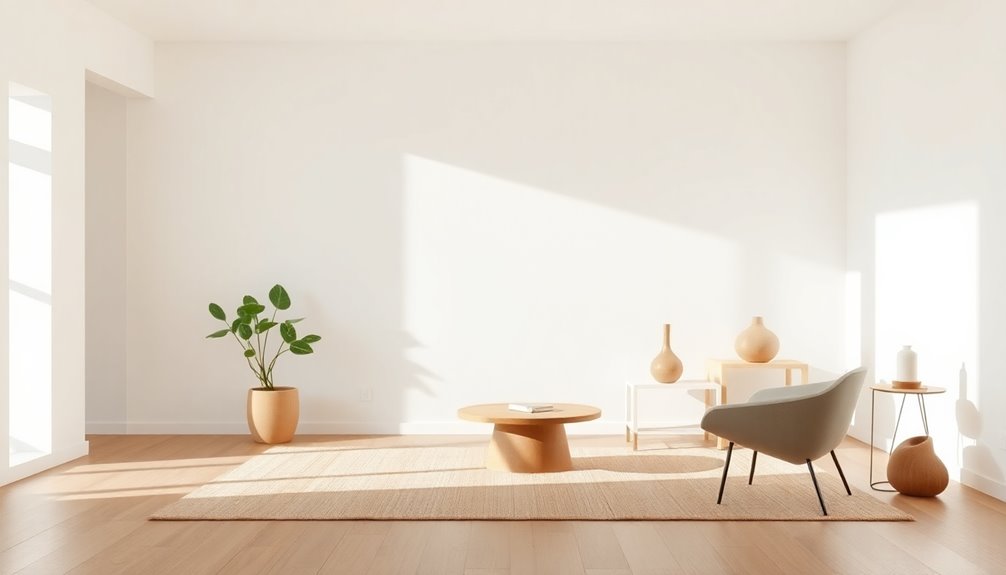
As you navigate the post-pandemic world, you might notice a compelling shift towards minimalist home decor, driven by a desire for calm and order in your living space.
This trend emphasizes clean lines and uncluttered spaces, allowing you to create an environment that fosters tranquility. With a focus on quality over quantity, you're likely to prioritize items that truly enhance your life and reflect your personal values.
Embrace clean lines and simplicity to cultivate a tranquil living space that reflects your true values.
Multi-functional furniture has become essential, enabling your home to adapt to various activities like work, relaxation, and socializing. The rise of earthy tones and natural materials further connects you to nature, promoting well-being. Incorporating multi-functional furniture allows for a seamless transition between different aspects of your daily life.
Embracing minimalism helps you eliminate distractions, leading to a more intentional and fulfilling lifestyle in your home.
Embracing Ethically Sourced Materials

While the appeal of minimalist design lies in its simplicity, the materials you choose can greatly enhance the ethical dimension of your space. The demand for ethically sourced materials has surged as you prioritize sustainability and transparency in production processes.
By selecting eco-friendly options like organic cotton, recycled plastics, and sustainably harvested wood, you align your interior design with your values. Certifications such as Fair Trade and Global Organic Textile Standard (GOTS) help you identify products that meet ethical sourcing standards.
A McKinsey & Company survey found that 67% of consumers consider sustainability when making purchases, pushing brands to embrace ethically sourced materials. This integration not only reduces environmental impact but also supports local economies, creating a more responsible design industry. Additionally, the use of sustainably harvested wood can mitigate the adverse effects of deforestation and climate change associated with traditional wood-burning practices.
The Rise of Biophilic Design

How can you create a space that not only looks good but also nurtures well-being? The rise of biophilic design has made people rethink their environments by integrating natural elements.
Embrace biophilic design to transform your space into a nurturing environment that enhances well-being.
This trend, amplified by social media, showcases how indoor plants and natural light can enhance air quality and create a calming atmosphere. As you embrace earthy tones like beige and terracotta, you'll foster a visual connection to nature, promoting serenity in your home.
The urban jungle concept emphasizes sustainability, allowing you to transform your indoor space into a green oasis. Incorporating non-toxic XL houseplants not only beautifies your environment but also ensures safety for your furry friends.
In the fashion world, this connection with nature reflects a growing desire for tranquility, enhancing mood and productivity while improving your overall quality of life.
Soft Shapes and Textures for Comfort
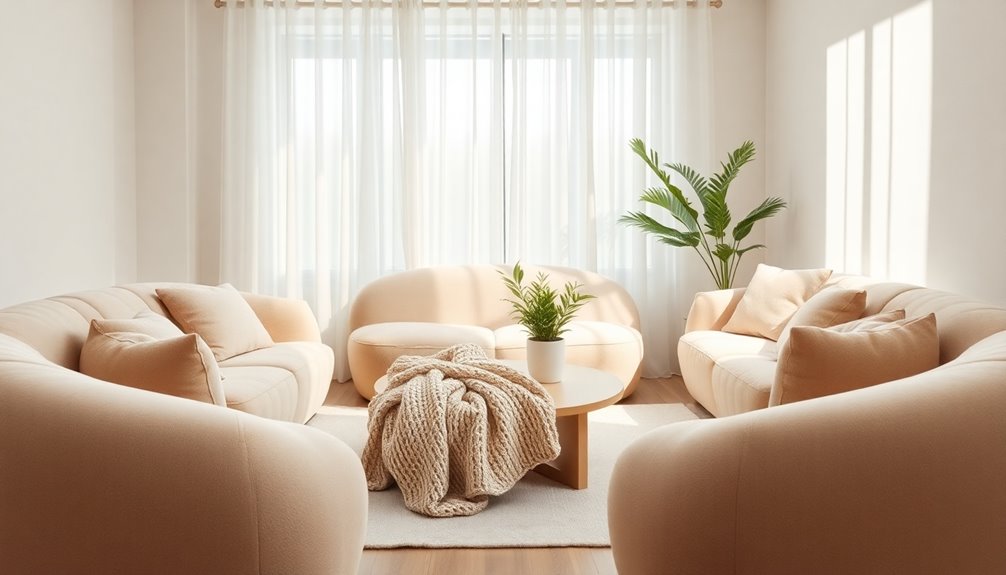
In your space, embracing organic curves can create a welcoming atmosphere that feels both cozy and inviting.
By layering different textures, you add visual interest while keeping that minimalist vibe intact.
Think about how soft shapes and varied fabrics can transform your environment into a serene retreat. Incorporating natural materials like wood can enhance the overall warmth and comfort of the space.
Embracing Organic Curves
Soft shapes and textures are essential for creating a comforting atmosphere in minimalist design. Embracing organic curves helps you cultivate a warm, inviting space that feels cozy and serene.
By incorporating these elements, you're not just enhancing aesthetics; you're fostering well-being. Modern farmhouse decor trends emphasize the use of natural materials and organic shapes, which align perfectly with this approach.
Here are some tips to embrace organic curves in your design:
- Choose Curvy Furniture: Opt for sofas and chairs with rounded edges to soften your space.
- Use Soft Textiles: Incorporate plush fabrics that invite touch, like velvet or boucle.
- Select Earthy Color Palettes: Stick to muted pastels and earthy tones for a calming effect.
- Add Textured Surfaces: Use fluted or ribbed materials to introduce visual interest without overwhelming simplicity.
These elements will help you create a tranquil environment.
Textural Layering Techniques
Embracing organic curves naturally leads to exploring textural layering techniques that enhance comfort in minimalist design.
By incorporating soft shapes and comforting textures, you create warm, inviting interiors. Think plush fabrics, cozy knits, and natural fibers that add depth while promoting relaxation.
The influence of Art Deco encourages a seamless flow, blending organic shapes with layered textures for visual appeal. Opt for soothing color palettes like soft pastels and earthy tones to heighten feelings of comfort, allowing your textures to shine.
Layering smooth surfaces with ribbed or fluted finishes enriches your space without sacrificing simplicity. This approach not only elevates aesthetics but also cultivates a nurturing environment that feels like home. Additionally, integrating natural elements like plants can enhance the overall comfort and tranquility of your minimalist design.
Multi-Functional Spaces in Modern Homes

As remote work becomes the norm, homeowners are reimagining their living spaces to serve multiple functions. This shift promotes versatility and adaptability, essential for modern living.
Here are four ways you can make your space multi-functional:
- Invest in versatile furniture: Look for sofa beds and extendable dining tables that maximize space.
- Create designated zones: Integrate a home office into your living area for work, relaxation, and socializing without separate rooms.
- Embrace decluttering techniques: Use methods like the Marie Kondo approach to maintain an airy, organized environment.
- Prioritize quality over status: Choose thoughtfully designed furniture that enhances functionality and supports a more intentional lifestyle.
The Importance of Natural Light and Earthy Tones
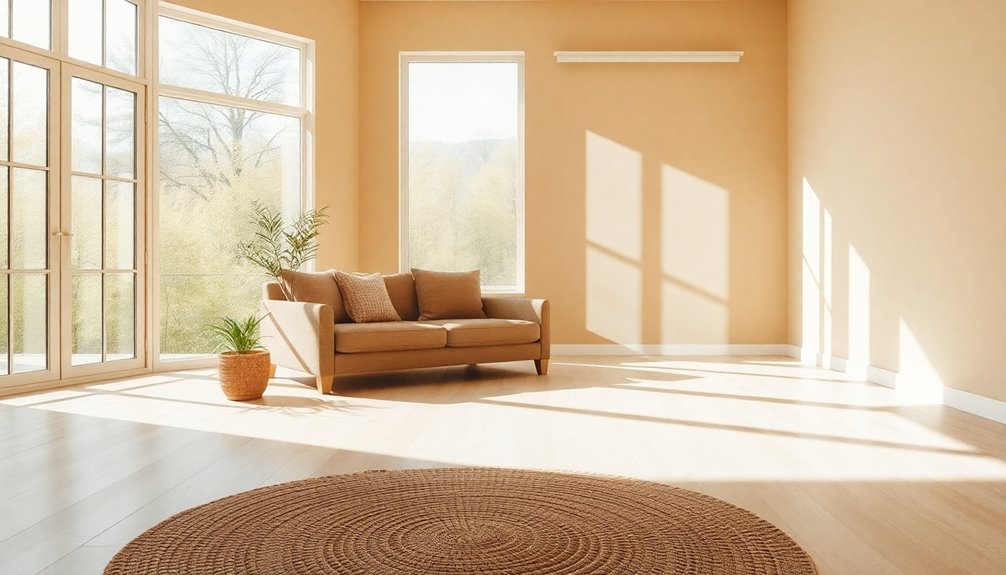
Natural light and earthy tones play an essential role in creating a serene and inviting atmosphere in your home. By prioritizing natural light, you can enhance your mood and energy, fostering a soothing environment that uplifts your spirit.
Large windows and open spaces are key in maximizing this light, contributing to an airy feel that supports your mental well-being.
Incorporating earthy tones like beige, brown, and terracotta helps promote tranquility and connects your space to nature. This trend aligns with biophilic design, which emphasizes natural elements for a calming aesthetic.
Plus, studies show that exposure to natural light boosts productivity and mental health, making it a crucial consideration in your post-pandemic home design. Embracing clear, achievable goals in your space organization can also enhance your overall productivity and satisfaction.
Embrace these elements for a revitalized living space.
Mindful Consumption and Sustainable Practices

As you navigate your purchases, think about how conscious choices can reflect your values and support sustainable practices.
Ethical material sourcing is becoming essential, and your decisions can drive demand for brands that prioritize the planet. Additionally, embracing mindfulness techniques can enhance your decision-making process and promote a more intentional approach to consumption.
Conscious Purchasing Habits
In today's post-pandemic world, conscious purchasing habits have gained significant traction, transforming how you approach shopping.
You're now more likely to prioritize quality and sustainability, reflecting a shift in values. Here are some ways you can embrace this trend:
- Choose sustainable brands: With 66% of consumers willing to pay more for eco-friendly options, your choices can make a difference.
- Support local artisans: By purchasing handmade items, you contribute to local economies and reduce transportation emissions.
- Embrace upcycling: Repurposing furniture not only reduces waste but adds unique character to your space.
- Focus on experiences: Prioritize purchases that enhance your lifestyle and align with your values over disposable goods.
These shifts promote a more mindful and sustainable approach to consumption. Furthermore, understanding the impact of astrological compatibility can enhance your decision-making process when selecting products that resonate with your personal values.
Ethical Material Sourcing
While the demand for minimalist design continues to rise, ethical material sourcing has become a cornerstone of mindful consumption.
You'll find that sustainable and eco-friendly materials, like organic textiles and recycled resources, are gaining traction in design. Consumers, like you, increasingly prefer brands that emphasize transparency, with 66% willing to pay more for sustainable options.
Supporting local artisans not only boosts community economies but also reduces transportation emissions. Upcycling and repurposing furniture reflect a shift away from fast fashion, promoting a sustainable approach to home decor.
Look for certifications like the Global Organic Textile Standard (GOTS) and Fair Trade labels, which help you make informed choices and guarantee your purchases align with your values. Additionally, embracing cultural intelligence (CQ) enhances your ability to understand and appreciate diverse sustainable practices across different cultures.
Frequently Asked Questions
How Can I Start Adopting a Minimalist Lifestyle Today?
To start adopting a minimalist lifestyle today, you can begin by decluttering your space. Go through your belongings and ask yourself what you truly need or love. Donate or sell items that don't serve a purpose.
Next, simplify your daily routines by prioritizing experiences over possessions. Set limits on new purchases and focus on quality over quantity.
Finally, embrace the idea of living with less, and you'll find more freedom and clarity in your life.
What Are the Benefits of Minimalist Design Beyond Aesthetics?
Imagine a garden where each flower blooms without overcrowding. That's what minimalist design offers you—space to breathe and clarity of thought.
Beyond aesthetics, it enhances functionality by eliminating distractions, making your environment more efficient. It fosters mindfulness, helping you focus on what truly matters.
By simplifying, you reduce stress and promote well-being, creating a sanctuary that encourages creativity and peace.
Embracing minimalism isn't just about looks; it's a pathway to a more fulfilling life.
How Do I Choose Versatile Pieces for My Wardrobe?
When choosing versatile pieces for your wardrobe, start with classic colors like black, white, and navy.
Look for items that can mix and match easily, like a tailored blazer or a simple dress. Opt for fabrics that adapt well between seasons, and consider different styling options.
Think about your lifestyle—do you need casual or formal pieces? Aim for quality over quantity; investing in a few key items will elevate your overall style.
Can Minimalist Design Work in Small Spaces?
Absolutely, minimalist design can thrive in small spaces!
You can maximize functionality by choosing multi-purpose furniture, like a sofa bed or an ottoman with storage.
Keep your color palette light and neutral to create an airy feel, and use mirrors to reflect light, making the space seem larger.
Decluttering is essential, too—only keep items that you love or need.
This way, you'll create a serene and stylish environment, even in limited square footage.
What Common Mistakes Should I Avoid in Minimalist Decorating?
When you're decorating with a minimalist approach, avoid cluttering your space with too many items.
Stick to a few key pieces that bring you joy or serve a purpose.
Don't overlook lighting—natural light enhances simplicity.
Also, steer clear of overly bold colors; opt for a neutral palette to maintain a calm atmosphere.
Finally, remember that functionality is key—each item should have a clear purpose, making your space both beautiful and practical.
Conclusion
As you embrace minimalist design in your home, remember that 75% of people report feeling less stressed in clutter-free spaces. By choosing ethically sourced materials, incorporating biophilic elements, and prioritizing natural light, you're not just creating a beautiful environment; you're nurturing your well-being. This post-pandemic world calls for mindful consumption and sustainable practices, allowing you to find comfort and peace in simplicity. Your space can reflect a lifestyle that values both aesthetics and the planet.
